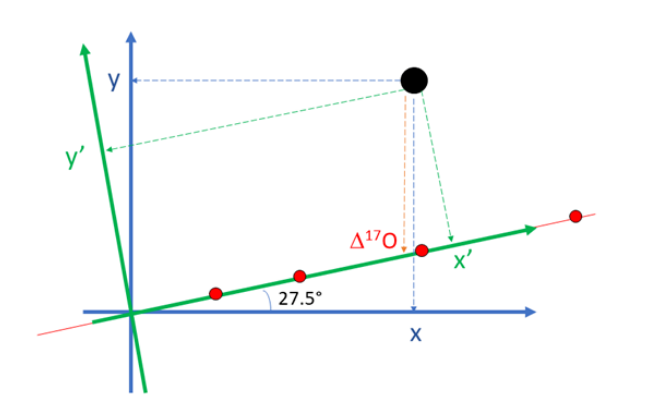In a triple isotope system, taking element oxygen for example, the deviation of a δ17O value from a defined δ17O-δ18O relationship is measured by the quantity Δ17O, defined as:

For mass-dependent processes, δ17O and δ18O data pairs (the 4 red-filled dots) will sit on a line (the thin red line in Fig) with a slope of 0.52 in δ17O-δ18O space. If we use a reference slope C value of 0.52, these δ17O and δ18O data would all display Δ17O values of 0 (i.e., all points on the thin red line will have Δ17O =0). This has been viewed by some as a transformation of an xy-Cartesian coordinate (thick blue in Fig) to a new x´y´-Cartesian coordinate system (thick green in Fig) by a simple rotation of axes without changing the origin. The degree of rotation is 27.5° counter clockwise, as arctan (0.52) =27.5° (Fig).
Can the Δ17O value (the length of the dashed thin red line in Fig) indeed be viewed as the new δ17O value (i.e., x´) after a rotation of axes?
No. As shown in Fig, a pair of δ17O and δ18O data in a new x´y´-Cartesian coordinate after rotation should have a new pair of δ´17O and δ´18O values x´and y´. However, the “Δ17O = δ17O – C×δ18O” formula still uses the values x and y in the old xy-coordinate system.
Why does it matter?
It matters because now the Δ17O value scales with its corresponding δ18O value. Often, the δ18O varies for a set of samples even when all the underlining physical-chemical processes and reaction mechanisms are the same for these samples. You would get different Δ17O values for samples experienced fundamentally the same processes simply because your reaction lasted longer or shorter, or your source isotope compositions are different. Yes, that would and has generated lots of confusions.
Do we have a better way to quantify the δ17O deviation from a reference process or to better quantify a triple isotope system in general?
I do not know one.
Remedy: Be sure to plot the corresponding δ18O when plotting the Δ17O data. A stand-alone Δ17O data plot without their associated δ18O can be dangerously misleading, especially when the Δ17O values are small.

